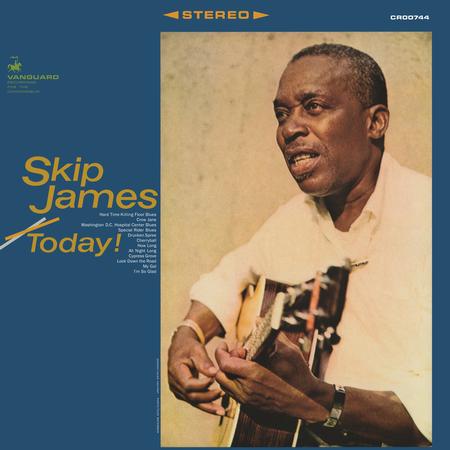I'm So Glad Bluesville Reissued This Skip James Classic!
best it has ever sounded and it never sounded bad
Series curator Scott Billington says it all in his obi strip annotation: "In the 1960s James may have startled listeners the most, because the haunting quality of his music had only deepened with time". Scott was referring to James's eerie, almost ghostly falsetto vocals that first appeared on record back in 1931 on the Paramount label.
This outing recorded January 9 and 10 1966 at Vanguard's 214 West 23rd Street New York City studio, is James's first album release though he'd recorded an earlier one for John Fahey's Takoma Records that wasn't issued until much later due to contractual disputes. Fahey and two others "discovered" him in a Mississippi hospital. James performed at the 1964 Newport Folk Festival (heard on Blues At Newport 1963—Part Two (Vanguard VSD 79181) and at least one of his songs made it to a compilation. It's a complicated discography.
Here he plays his open tuning guitar and occasional barrelhouse-style piano, accompanied on one track by Vanguard's "go to" bassist Russ Savakus. There's plenty or "room sound" behind the instruments, helping to put James in three dimensions in a three-dimensional studio space.
In the annotation James is quoted as saying "I don't sing other people's songs, I don't sing other people's voices. I can't." That's a good thing. And no one can sing in his. The subject matter is mostly the familiar: hard depression times, temptresses, etc. but there's also one song about James's hospital stay in Washington D.C. shortly after he was released from the Mississippi hospital in which he was "discovered", and one about his work cutting timber.
The Solomon Brothers Maynard and Seymour were always sound-conscious and most Vanguard records, regardless of musical genre, sounded transparent, three dimensional and involving, whether recorded by Vanguard or licensed from overseas.
All of the mid sixties Vanguard folk records, whether by The Weavers or Ian & Sylvia—name your favorite—share this silky, liquid string sound that combines supple yet precise transient attack, and "reach out and touch it" sustain and decay against black backgrounds. The absence of tape hiss is notable.
James (and listeners too) deserves this level of recorded sound. James's finger picking precision is remarkable and this recording gets all of it in every category. The bass lines are deeply felt, the treble ones shimmer and the guitar body fully fills in the picture. If any compression was used during the recording it was dialed down to minimum. This records lives and breathes almost sixty years after it was put to tape, perhaps by Marc Aubort?
I have multiple copies of this record and this Bluesville reissue is by far the best sounding. It puts you in the room with the artist, or the artist in your room, whichever you prefer and there's no mystery about why that is.
Matthew Lutthans cut lacquers multiple ways: from the original two track tape, from a mix down he created from the four track tape and finally a live to lathe cut, which is what this is. The improvement in "you are there" transparency will be obvious to anyone reading this who's a fan of the record and has a previous iteration.
Add Doug Sax's lathe, once again operating as TML fans expect, a dead quiet QRP pressing, a Stoughton "Tip-on" jacket and a $29.98 price and this is a "must have" reissue, especially worth picking up if you're unfamiliar with the record and/or the artist, though of course everyone knows Cream's cover of "I'm So Glad" found here in the original version (though if you listen casually it sounds nothing like the "rocked up" cover). Another plus is Bruce Jackson's excellent original annotation that tells the whole story and more. And you get the original orange Vanguard Stereolab label (by 1966 the black and silver label had been changed to orange and black).
The Bluesville series is now two for two!













































